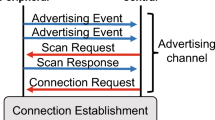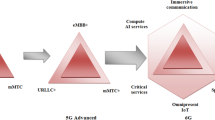Abstract
Cognitive communication model perform the investigation and surveillance of spectrum in cognitive radio networks abetment in advertent primary users (PUs) and in turn help in allocation of transmission space for secondary users (SUs). In effective performance of regulation of wireless channel handover strategy in cognitive computing systems, new computing models are desired in operating set of tasks to process business model, and interact naturally with humans or machine rather being programmed. Cognitive wireless network are trained via artificial intelligence (AI) and machine learning (ML) algorithms for dynamic processing of spectrum handovers. They assist human experts in making enhanced decisions by penetrating into the complexity of the handovers. This paper focuses on learning and reasoning features of cognitive radio (CR) by analyzing primary user (PU) and secondary user (SU) data communication using home location register (HLR) and visitor location register (VLR) database respectively. The SpecPSO is proposed for optimizing handovers using supervised machine learning technique for performing dynamic handover by adapting to the environment and make smart decisions compared to the traditional cooperative spectrum sensing (CSS) techniques.











Similar content being viewed by others
References
Jo, O., Cho, D.H.: Seamless spectrum handover considering differential path-loss in cognitive radio systems. IEEE Commun. Lett. 13(3), 190–192 (2009). doi:10.1109/LCOMM.2009.081496
Au, E.K., Cavalcanti, D., Li, G.Y., Caldwell, W., Letaief, K.B.: Advances in standards and testbeds for cognitive radio networks: part I. IEEE Commun. Mag. 48(9), 76–77 (2010). doi:10.1109/MCOM.2010.5560590. Guest Editorial
Celebi, H., Arslan, H.: Utilization of location information in cognitive wireless networks. IEEE Wirel. Commun. 14(4), 6–13 (2007). doi:10.1109/MWC.2007.4300977
Wang, B., Liu, K.J.: Advances in cognitive radio networks: a survey. IEEE J. Sel. Top. Signal Process. 5, 5–23 (2011)
Suganya, M., Anandakumar, H.: Handover based spectrum allocation in cognitive radio networks. In: 2013 International Conference on Green Computing, Communication and Conservation of Energy (ICGCE), Chennai, 2013, pp. 215–219. doi:10.1109/ICGCE.2013.6823431
Zhao, Q., Sadler, B.M.: A survey of dynamic spectrum access. IEEE Signal Process. Mag. 24, 79–89 (2007)
Lu, L., Zhou, X., Onunkwo, U., Li, G.Y.: Ten years of research in spectrum sensing and sharing in cognitive radio. EURASIP J. Wirel. Commun. Netw. 2012, 28 (2012)
Wu, Y., Yang, Z.: Coexistence of primary users and secondary users under interference temperature and SINR limit. J. Electron 26, 303–311 (2009)
Sherman, M., Mody, A.N., Martinez, R., Rodriguez, C., Reddy, R.: IEEE standards supporting cognitive radio and networks, dynamic spectrum access, and coexistence. IEEE Commun. Mag. 46(7), 72–79 (2008). doi:10.1109/MCOM.2008.4557045
Singh, J.S.P., Singh, R., Rai, M.K., et al.: Cooperative sensing for cognitive radio: a powerful access method for shadowing environment. Wirel. Pers. Commun. 80, 1363 (2015). doi:10.1007/s11277-014-2088-1
Mitola III.: Cognitive Radio: An Integrated Agent Architecture for Software Defined Radio, Ph.D. dissertation. Royal Institute of Technology (KTH) Stockholm (2000)
Akyildiz, I.F., Lee, M.Y., Vuran, M.C.: Next generation dynamic spectrum access/cognitive radio wireless networks: a survey. Comput. Netw. 50(13), 2127–2159 (2006)
Kim, E., Moon, J.: A new approach to deploying private mobile network exploits. J. Supercomput. 72, 46 (2016). doi:10.1007/s11227-015-1461-5
Gill, H., Lin, D., Nguyen, C., et al.: Declarative platform for high-performance network traffic analytics. Clust. Comput. 17, 1121 (2014). doi:10.1007/s10586-014-0363-2
Clancy, C., Hecker, J., Stuntebeck, E., O’Shea, T.: Applications of machine learning to cognitive radio networks. IEEE Wirel. Commun. 14(4), 47–52 (2007). doi:10.1109/MWC.2007.4300983
Kasabov, N., Zhou, L., Doborjeh, M.G., Doborjeh, Z.G., Yang, J.: New algorithms for encoding, learning and classification of fmri data in a spiking neural network architecture: a case on modelling and understanding of dynamic cognitive processes. In: IEEE Transactions on Cognitive and Developmental Systems, vol. 99, pp. 1. doi:10.1109/TCDS.2016.2636291
Azmat, F., Chen, Y., Stocks, N.: Analysis of spectrum occupancy using machine learning algorithms. IEEE Trans. Veh. Technol. 65(9), 6853–6860 (2016). doi:10.1109/TVT.2015.2487047
Pratama, M., Zhang, G., Er, M.J., Anavatti, S.: An incremental type-2 meta-cognitive extreme learning machine. IEEE Trans. Cybern. 47(2), 339–353 (2017). doi:10.1109/TCYB.2016.2514537
Gong, X., Vorobyov, S.A., Tellambura, C.: Optimal bandwidth and power allocation for sum ergodic capacity under fading channels in cognitive radio networks. IEEE Trans. Signal Process. 59(4), 1814–1826 (2011)
Chen, Y.S., Hong, J.S.: A relay-assisted protocol for spectrum mobility and handover in cognitive LTE networks. IEEE Syst. J. 7(1), 77–91 (2013). doi:10.1109/JSYST.2012.2205089
Lu, D., Huang, X., Liu, C., Fan, J.: Adaptive power control based spectrum handover for cognitive radio networks. In: IEEE Wireless Communication and Networking Conference, pp. 1–5. Sydney, NSW (2010). doi:10.1109/WCNC.2010.5506405
Thilina, K.M., Choi, K.W., Saquib, N., Hossain, E.: Machine learning techniques for cooperative spectrum sensing in cognitive radio networks. IEEE J. Sel. Areas Commun. 31(11), 2209–2221 (2013). doi:10.1109/JSAC.2013.131120
Yuan, W., Leung, H., Cheng, W., Chen, S.: Optimizing voting rule for cooperative spectrum sensing through learning automata. IEEE Trans. Veh. Technol. 60(7), 3253–3264 (2011). doi:10.1109/TVT.2011.2161001
Chen, H., Zhou, M., Xie, L., Wang, K., Li, J.: Joint spectrum sensing and resource allocation scheme in cognitive radio networks with spectrum sensing data falsification attack. IEEE Trans. Veh. Technol. 65(11), 9181–9191 (2016)
Zhang, F., Zhou, X., Cao, X.: Location-oriented evolutionary games for price-elastic spectrum sharing. IEEE Trans. Commun. 64(9), 3958–3969 (2016). doi:10.1109/TCOMM.2016.2590418
Ma, W., Fang, Y.: A pointer forwarding based local anchoring (POFLA) scheme for wireless networks. IEEE Trans. Veh. Technol. 54(3), 1135–1146 (2005). doi:10.1109/TVT.2005.844651
Anandakumar, H., Umamaheswari, K.: Energy efficient network selection using 802.16g based GSM Technology. J. Comput. Sci. 10(5), 745–754 (2014). doi:10.3844/jcssp.2014.745.754
Gavrilovska, L., Atanasovski, V., Macaluso, I., DaSilva, L.: Learning and reasoning in cognitive radio networks. IEEE Commun. Surv. Tutor. 15(4), 1761–1777 (2013)
Lee, D., Helal, A.S., Sung, Y., Anton, S.: Situation-based assess tree for user behavior assessment in persuasive telehealth. IEEE Trans. Hum. Mach. Syst. 45(5), 624–634 (2015). doi:10.1109/THMS.2015.2443712
Choi, K.W., Hossain, E., Kim, D.I.: Cooperative spectrum sensing under a random geometric primary user network model. IEEE Trans. Wirel. Commun. 10(6), 1932–1944 (2011). doi:10.1109/TWC.2011.040411.101430
Cabric, D., Mishra, S.M., Brodersen, R.W.: Implementation issues in spectrum sensing for cognitive radios. In: Conference Record of the Thirty-Eighth Asilomar Conference on Signals, Systems and Computers, 2004, vol. 1, pp. 772–776, 2004. doi:10.1109/ACSSC.2004.1399240
Yucek, T., Arslan, H.: A survey of spectrum sensing algorithms for cognitive radio applications. IEEE Commun. Surv. Tutor. 11(1), 116–130 (2009). doi:10.1109/SURV.2009.090109
Shen, J., Jiang, T., Liu, S., Zhang, Z.: Maximum channel throughput via cooperative spectrum sensing in cognitive radio networks. IEEE Trans. Wirel. Commun. 8(10), 5166–5175 (2009). doi:10.1109/TWC.2009.081110
Zhao, Z., Peng, Z., Zheng, S., Shang, J.: Cognitive radio spectrum allocation using evolutionary algorithms. IEEE Trans. Wirel. Commun. 8(9), 4421–4425 (2009). doi:10.1109/TWC.2009.080939
Sadreddini, Z., Güler, E., Çavdar, T.: PSO-optimized Instant Overbooking Framework for cognitive radio networks. In: 2015 38th International Conference on Telecommunications and Signal Processing (TSP), Prague, 2015, pp. 49–53. doi:10.1109/TSP.2015.7296222
Wang, G., Guo, C., Feng, S., Feng, C., Wang, S.: A two-stage cooperative spectrum sensing method for energy efficiency improvement in cognitive radio. In: 2013 IEEE 24th Annual International Symposium on Personal, Indoor, and Mobile Radio Communications (PIMRC), London, 2013, pp. 876–880. doi:10.1109/PIMRC.2013.6666260
Xu, H., Zhou, Z.: Cognitive radio decision engine using hybrid binary particle swarm optimization. In: 2013 13th International Symposium on Communications and Information Technologies (ISCIT), Surat Thani, 2013, pp. 143–147. doi:10.1109/ISCIT.2013.6645839
Author information
Authors and Affiliations
Corresponding author
Rights and permissions
About this article
Cite this article
Anandakumar, H., Umamaheswari, K. Supervised machine learning techniques in cognitive radio networks during cooperative spectrum handovers. Cluster Comput 20, 1505–1515 (2017). https://doi.org/10.1007/s10586-017-0798-3
Received:
Revised:
Accepted:
Published:
Issue Date:
DOI: https://doi.org/10.1007/s10586-017-0798-3




